2N3904 Silicon NPN Transistor[FAQ]:Datasheet, Pinout, Equivalent and Package
TRANS NPN 40V 0.2A TO-92
The 2N3904 is one of the most commonly used general-purpose NPN transistors in electronics. This passage is going to introduce 2N3904 from the perspectives of datasheet, applications, equivalent, manufacturer, and package.

3 Simple Electronic Project using 2n3904
- 2N3904 Description
- 2N3904 CAD Models
- 2N3904 pinout and configurations
- Specifications
- 2N3904 Features
- 2N3904 Equivalent NPN Transistors:
- 2N3904 as switch
- 2N3904 as Amplifier
- 2N3904 Applications:
- 2N3904 Alternatives
- 2N3904 Package
- 2N3904 Manufacturer
- 2N3904 vs 2N2222
- Trend Analysis
- Datasheet PDF
- Parts with Similar Specs
2N3904 Description
Because the 2N3904 is an NPN transistor when the base pin is held at the ground, the collector and emitter are left open (reverse biased), and when a signal is applied to the base pin, the collector and emitter are closed (forward-biased). The gain value of the 2N3904 is 300, which controls the transistor's amplification capacity. Because the maximum amount of current that can flow through the Collector pin is 200mA, we can't use this transistor to connect loads that need more than 200mA. We must feed current to the base pin of a transistor to bias it, and this current (IB) should be limited to 5mA.
When fully biased, this transistor can enable a maximum of 200mA to flow between the collector and emitter. The normal voltage allowed across the Collector-Emitter (VCE) or Collector-Base (VCB) could be 40V or 60V, respectively, in the Saturation Region. The transistor gets entirely off when the base current is eliminated; this stage is known as the Cut-off Region, and the Base Emitter voltage may be approximately 600mV.
2N3904 CAD Models
Symbol
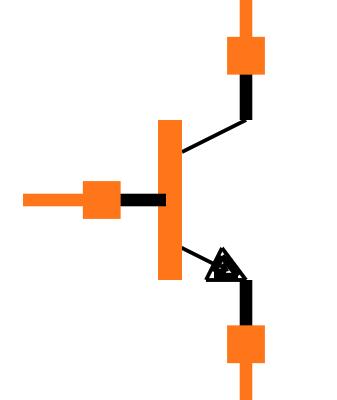
Footprint
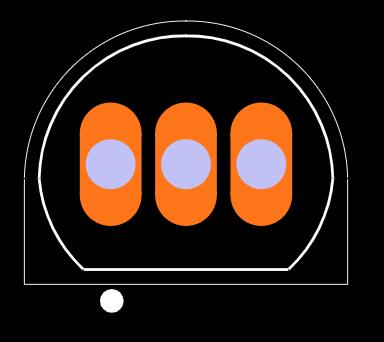
3D Models

2N3904 pinout and configurations

| Pin Number | Pin Name | Description |
| 1 | Emitter | Current Drains out through emitter |
| 2 | Base | Controls the biasing of transistor |
| 3 | Collector | Current flows in through collector |
Specifications
- TypeParameter
- Mount
In electronic components, the term "Mount" typically refers to the method or process of physically attaching or fixing a component onto a circuit board or other electronic device. This can involve soldering, adhesive bonding, or other techniques to secure the component in place. The mounting process is crucial for ensuring proper electrical connections and mechanical stability within the electronic system. Different components may have specific mounting requirements based on their size, shape, and function, and manufacturers provide guidelines for proper mounting procedures to ensure optimal performance and reliability of the electronic device.
Through Hole - Mounting Type
The "Mounting Type" in electronic components refers to the method used to attach or connect a component to a circuit board or other substrate, such as through-hole, surface-mount, or panel mount.
Through Hole - Package / Case
refers to the protective housing that encases an electronic component, providing mechanical support, electrical connections, and thermal management.
TO-226-3, TO-92-3 (TO-226AA) - Transistor Element Material
The "Transistor Element Material" parameter in electronic components refers to the material used to construct the transistor within the component. Transistors are semiconductor devices that amplify or switch electronic signals and are a fundamental building block in electronic circuits. The material used for the transistor element can significantly impact the performance and characteristics of the component. Common materials used for transistor elements include silicon, germanium, and gallium arsenide, each with its own unique properties and suitability for different applications. The choice of transistor element material is crucial in designing electronic components to meet specific performance requirements such as speed, power efficiency, and temperature tolerance.
SILICON - Collector-Emitter Breakdown Voltage40V
- Number of Elements1
- hFEMin30
- Operating Temperature
The operating temperature is the range of ambient temperature within which a power supply, or any other electrical equipment, operate in. This ranges from a minimum operating temperature, to a peak or maximum operating temperature, outside which, the power supply may fail.
150°C TJ - Packaging
Semiconductor package is a carrier / shell used to contain and cover one or more semiconductor components or integrated circuits. The material of the shell can be metal, plastic, glass or ceramic.
Bulk - JESD-609 Code
The "JESD-609 Code" in electronic components refers to a standardized marking code that indicates the lead-free solder composition and finish of electronic components for compliance with environmental regulations.
e3 - Part Status
Parts can have many statuses as they progress through the configuration, analysis, review, and approval stages.
Obsolete - Moisture Sensitivity Level (MSL)
Moisture Sensitivity Level (MSL) is a standardized rating that indicates the susceptibility of electronic components, particularly semiconductors, to moisture-induced damage during storage and the soldering process, defining the allowable exposure time to ambient conditions before they require special handling or baking to prevent failures
1 (Unlimited) - Number of Terminations3
- ECCN Code
An ECCN (Export Control Classification Number) is an alphanumeric code used by the U.S. Bureau of Industry and Security to identify and categorize electronic components and other dual-use items that may require an export license based on their technical characteristics and potential for military use.
EAR99 - Terminal Finish
Terminal Finish refers to the surface treatment applied to the terminals or leads of electronic components to enhance their performance and longevity. It can improve solderability, corrosion resistance, and overall reliability of the connection in electronic assemblies. Common finishes include nickel, gold, and tin, each possessing distinct properties suitable for various applications. The choice of terminal finish can significantly impact the durability and effectiveness of electronic devices.
Matte Tin (Sn) - Voltage - Rated DC
Voltage - Rated DC is a parameter that specifies the maximum direct current (DC) voltage that an electronic component can safely handle without being damaged. This rating is crucial for ensuring the proper functioning and longevity of the component in a circuit. Exceeding the rated DC voltage can lead to overheating, breakdown, or even permanent damage to the component. It is important to carefully consider this parameter when designing or selecting components for a circuit to prevent any potential issues related to voltage overload.
60V - Max Power Dissipation
The maximum power that the MOSFET can dissipate continuously under the specified thermal conditions.
625mW - Terminal Position
In electronic components, the term "Terminal Position" refers to the physical location of the connection points on the component where external electrical connections can be made. These connection points, known as terminals, are typically used to attach wires, leads, or other components to the main body of the electronic component. The terminal position is important for ensuring proper connectivity and functionality of the component within a circuit. It is often specified in technical datasheets or component specifications to help designers and engineers understand how to properly integrate the component into their circuit designs.
BOTTOM - Peak Reflow Temperature (Cel)
Peak Reflow Temperature (Cel) is a parameter that specifies the maximum temperature at which an electronic component can be exposed during the reflow soldering process. Reflow soldering is a common method used to attach electronic components to a circuit board. The Peak Reflow Temperature is crucial because it ensures that the component is not damaged or degraded during the soldering process. Exceeding the specified Peak Reflow Temperature can lead to issues such as component failure, reduced performance, or even permanent damage to the component. It is important for manufacturers and assemblers to adhere to the recommended Peak Reflow Temperature to ensure the reliability and functionality of the electronic components.
NOT SPECIFIED - Reach Compliance Code
Reach Compliance Code refers to a designation indicating that electronic components meet the requirements set by the Registration, Evaluation, Authorization, and Restriction of Chemicals (REACH) regulation in the European Union. It signifies that the manufacturer has assessed and managed the chemical substances within the components to ensure safety and environmental protection. This code is vital for compliance with regulations aimed at minimizing risks associated with hazardous substances in electronic products.
not_compliant - Current Rating
Current rating is the maximum current that a fuse will carry for an indefinite period without too much deterioration of the fuse element.
200mA - Time@Peak Reflow Temperature-Max (s)
Time@Peak Reflow Temperature-Max (s) refers to the maximum duration that an electronic component can be exposed to the peak reflow temperature during the soldering process, which is crucial for ensuring reliable solder joint formation without damaging the component.
NOT SPECIFIED - Base Part Number
The "Base Part Number" (BPN) in electronic components serves a similar purpose to the "Base Product Number." It refers to the primary identifier for a component that captures the essential characteristics shared by a group of similar components. The BPN provides a fundamental way to reference a family or series of components without specifying all the variations and specific details.
2N39 - Pin Count
a count of all of the component leads (or pins)
3 - JESD-30 Code
JESD-30 Code refers to a standardized descriptive designation system established by JEDEC for semiconductor-device packages. This system provides a systematic method for generating designators that convey essential information about the package's physical characteristics, such as size and shape, which aids in component identification and selection. By using JESD-30 codes, manufacturers and engineers can ensure consistency and clarity in the specification of semiconductor packages across various applications and industries.
O-PBCY-T3 - Qualification Status
An indicator of formal certification of qualifications.
Not Qualified - Element Configuration
The distribution of electrons of an atom or molecule (or other physical structure) in atomic or molecular orbitals.
Single - Power Dissipation
the process by which an electronic or electrical device produces heat (energy loss or waste) as an undesirable derivative of its primary action.
625mW - Transistor Application
In the context of electronic components, the parameter "Transistor Application" refers to the specific purpose or function for which a transistor is designed and used. Transistors are semiconductor devices that can amplify or switch electronic signals and are commonly used in various electronic circuits. The application of a transistor can vary widely depending on its design and characteristics, such as whether it is intended for audio amplification, digital logic, power control, or radio frequency applications. Understanding the transistor application is important for selecting the right type of transistor for a particular circuit or system to ensure optimal performance and functionality.
SWITCHING - Gain Bandwidth Product
The gain–bandwidth product (designated as GBWP, GBW, GBP, or GB) for an amplifier is the product of the amplifier's bandwidth and the gain at which the bandwidth is measured.
270MHz - Polarity/Channel Type
In electronic components, the parameter "Polarity/Channel Type" refers to the characteristic that determines the direction of current flow or the type of signal that can be accommodated by the component. For components like diodes and transistors, polarity indicates the direction in which current can flow through the component, such as forward bias or reverse bias for diodes. For components like MOSFETs or JFETs, the channel type refers to whether the component is an N-channel or P-channel device, which determines the type of charge carriers that carry current through the component. Understanding the polarity or channel type of a component is crucial for proper circuit design and ensuring that the component is connected correctly to achieve the desired functionality.
NPN - Transistor Type
Transistor type refers to the classification of transistors based on their operation and construction. The two primary types are bipolar junction transistors (BJTs) and field-effect transistors (FETs). BJTs use current to control the flow of current, while FETs utilize voltage to control current flow. Each type has its own subtypes, such as NPN and PNP for BJTs, and MOSFETs and JFETs for FETs, impacting their applications and characteristics in electronic circuits.
NPN - Collector Emitter Voltage (VCEO)
Collector-Emitter Voltage (VCEO) is a key parameter in electronic components, particularly in transistors. It refers to the maximum voltage that can be applied between the collector and emitter terminals of a transistor while the base terminal is open or not conducting. Exceeding this voltage limit can lead to breakdown and potential damage to the transistor. VCEO is crucial for ensuring the safe and reliable operation of the transistor within its specified limits. Designers must carefully consider VCEO when selecting transistors for a circuit to prevent overvoltage conditions that could compromise the performance and longevity of the component.
200mV - Max Collector Current
Max Collector Current is a parameter used to specify the maximum amount of current that can safely flow through the collector terminal of a transistor or other electronic component without causing damage. It is typically expressed in units of amperes (A) and is an important consideration when designing circuits to ensure that the component operates within its safe operating limits. Exceeding the specified max collector current can lead to overheating, degradation of performance, or even permanent damage to the component. Designers must carefully consider this parameter when selecting components and designing circuits to ensure reliable and safe operation.
200mA - DC Current Gain (hFE) (Min) @ Ic, Vce
The parameter "DC Current Gain (hFE) (Min) @ Ic, Vce" in electronic components refers to the minimum value of the DC current gain, denoted as hFE, under specific operating conditions of collector current (Ic) and collector-emitter voltage (Vce). The DC current gain hFE represents the ratio of the collector current to the base current in a bipolar junction transistor (BJT), indicating the amplification capability of the transistor. The minimum hFE value at a given Ic and Vce helps determine the transistor's performance and efficiency in amplifying signals within a circuit. Designers use this parameter to ensure proper transistor selection and performance in various electronic applications.
100 @ 10mA 1V - Vce Saturation (Max) @ Ib, Ic
The parameter "Vce Saturation (Max) @ Ib, Ic" in electronic components refers to the maximum voltage drop across the collector-emitter junction when the transistor is in saturation mode. This parameter is specified at a certain base current (Ib) and collector current (Ic) levels. It indicates the minimum voltage required to keep the transistor fully conducting in saturation mode, ensuring that the transistor operates efficiently and does not enter the cutoff region. Designers use this parameter to ensure proper transistor operation and to prevent overheating or damage to the component.
200mV @ 5mA, 50mA - Transition Frequency
Transition Frequency in electronic components refers to the frequency at which a device can transition from one state to another, typically defining the upper limit of its operating frequency. It is a critical parameter in determining the speed and performance of active components like transistors and integrated circuits. This frequency is influenced by factors such as capacitance, resistance, and the inherent characteristics of the materials used in the component's construction. Understanding transition frequency is essential for optimizing circuit designs and ensuring reliable signal processing in various applications.
270MHz - Collector Base Voltage (VCBO)
Collector Base Voltage (VCBO) is the maximum allowable voltage that can be applied between the collector and base terminals of a bipolar junction transistor when the emitter is open. It is a critical parameter that determines the voltage rating of the transistor and helps prevent breakdown in the collector-base junction. Exceeding this voltage can lead to permanent damage or failure of the component.
60V - Emitter Base Voltage (VEBO)
Emitter Base Voltage (VEBO) is a parameter used in electronic components, particularly in transistors. It refers to the maximum voltage that can be applied between the emitter and base terminals of a transistor without causing damage to the device. Exceeding this voltage limit can lead to breakdown of the transistor and potential failure. VEBO is an important specification to consider when designing circuits to ensure the proper operation and reliability of the components. It is typically provided in the datasheet of the transistor and should be carefully observed to prevent any potential damage during operation.
6V - Turn Off Time-Max (toff)
The parameter "Turn Off Time-Max (toff)" in electronic components refers to the maximum time taken for a device to switch from an ON state to an OFF state. It is a crucial specification in devices such as transistors, diodes, and other semiconductor components that control the flow of current. The turn-off time is important for determining the switching speed and efficiency of a component, as a shorter turn-off time generally indicates faster operation and reduced power losses. Designers and engineers use this parameter to ensure proper functioning and performance of electronic circuits and systems.
250ns - Turn On Time-Max (ton)
Turn On Time-Max (ton) is a parameter in electronic components that refers to the maximum time it takes for a device to transition from an off state to an on state when a specific input signal is applied. This parameter is crucial in determining the speed and efficiency of the component in switching operations. A shorter turn-on time indicates faster response and better performance in applications where quick switching is required. It is typically specified in the component's datasheet and is important for designers to consider when selecting components for their circuits to ensure proper functionality and timing requirements are met.
70ns - REACH SVHC
The parameter "REACH SVHC" in electronic components refers to the compliance with the Registration, Evaluation, Authorization, and Restriction of Chemicals (REACH) regulation regarding Substances of Very High Concern (SVHC). SVHCs are substances that may have serious effects on human health or the environment, and their use is regulated under REACH to ensure their safe handling and minimize their impact.Manufacturers of electronic components need to declare if their products contain any SVHCs above a certain threshold concentration and provide information on the safe use of these substances. This information allows customers to make informed decisions about the potential risks associated with using the components and take appropriate measures to mitigate any hazards.Ensuring compliance with REACH SVHC requirements is essential for electronics manufacturers to meet regulatory standards, protect human health and the environment, and maintain transparency in their supply chain. It also demonstrates a commitment to sustainability and responsible manufacturing practices in the electronics industry.
No SVHC - RoHS Status
RoHS means “Restriction of Certain Hazardous Substances” in the “Hazardous Substances Directive” in electrical and electronic equipment.
ROHS3 Compliant - Lead Free
Lead Free is a term used to describe electronic components that do not contain lead as part of their composition. Lead is a toxic material that can have harmful effects on human health and the environment, so the electronics industry has been moving towards lead-free components to reduce these risks. Lead-free components are typically made using alternative materials such as silver, copper, and tin. Manufacturers must comply with regulations such as the Restriction of Hazardous Substances (RoHS) directive to ensure that their products are lead-free and environmentally friendly.
Lead Free
2N3904 Features
1. Bi-Polar NPN Transistor
2. DC Current Gain (hFE) is 300 maximum
3. Continuous Collector current (IC) is 200mA
4. Base- Emitter Voltage (VBE) is 6V
5. Collector-Emitter Voltage (VCE) is 40V
6. Collector-Base Voltage (VCB) is 60V
7. Available in To-92 Package
2N3904 Equivalent NPN Transistors:
2N3904 as switch
When a transistor is utilized as a switch, it operates in the Saturation and Cut-Off Regions, as previously discussed. As previously stated, a transistor will behave as an open switch during forwarding Bias and as a closed switch during Reverse Bias when the proper amount of current is supplied to the base pin. As previously stated, the biasing current should not exceed 5mA. Any current more than 5mA will destroy the transistor, hence a resistor is always connected in series with the base pin.
2N3904 as Amplifier
When in the Active Region, a transistor operates as an amplifier. It has the ability to magnify power, voltage, and current in a variety of configurations.
The following are some of the configurations found in amplifier circuits:
Amplifier with common emitter
Amplifier with common collector
Amplification with a common basis
2N3904 Applications:
Driver Modules like Relay Driver, LED driver, etc...
Amplifier modules like Audio amplifiers, signal Amplifiers, etc...
VCB and VBE are high hence can be used to control voltage loads up to 40V
Commonly used in TV and other home appliances
2N3904 Package
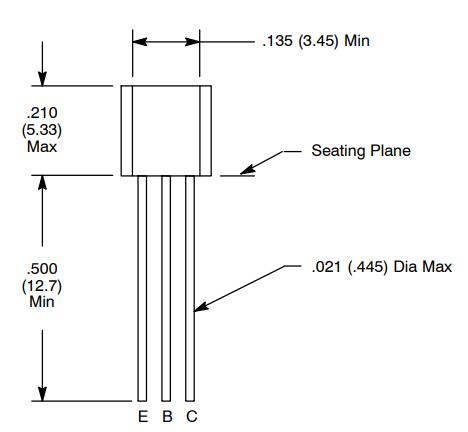
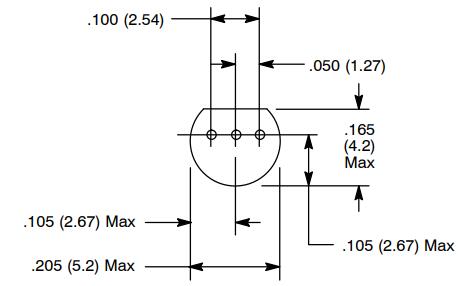
TO-92
2N3904 Manufacturer
STMicroelectronics is a global electronics and semiconductors company headquartered in Plan-les-Ouates, Switzerland, near Geneva. In 1987, the firm was formed by the merger of two government-owned semiconductor companies: France's "Thomson Semiconducteurs" and Italy's "SGS Microelettronica [it]." It is known as "ST" and is Europe's largest semiconductor chip manufacturer in terms of revenue. While STMicroelectronics' corporate headquarters and EMEA regional offices are located in Geneva, the holding company, STMicroelectronics N.V., is based in the Netherlands.
Coppell, Texas is where the company's US headquarters are located. The Asia-Pacific region's headquarters are in Singapore, while Japan and Korea's operations are based in Tokyo. Shanghai is where the company's China regional headquarters are located.
2N3904 vs 2N2222
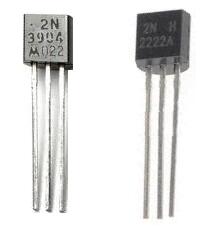
The 2N3904 and 2N2222 are two of the most widely used NPN bipolar junction transistors on the market today.
Comparing transistors isn't difficult because there are just a few key parameters to consider. Below is a table that compares and contrasts transistors, as well as an explanation of what each item in the table implies.
| 2N3904 | 2N2222 | |
| Type of Transistor | bipolar junction transistor (BJT) | Bipolar junction transistor (BJT) |
| Type of BJT | NPN | NPN |
| The maximum current that the transistor can handle from the emitter to the collector (called collector current, Ic) | 200mA | 1A |
| The maximum voltage that the collector of the transistor can handle (called the collector-emitter voltage, V CEO ) | 40V | 40V |
Trend Analysis
Datasheet PDF
- Datasheets :
Parts with Similar Specs
What is 2N3904?
The 2N3904 is an extremely popular NPN transistor that is used as a simple electronic switch or amplifier that can handle 200 mA (absolute maximum) and frequencies as high as 100 MHz when used as an amplifier.
Is BC547 same as 2N3904?
Because the transistors 2N3904 and BC547 are nearly identical and have few differences, they can be utilized interchangeably in most situations.
What is the difference between 2N3904 and 2N2222?
2N3904 can handle up to 200mA (milliamperes) of current flowing from the emitter to the collector terminal. A 2N2222 can handle up to 5 times that amount of current, as it can handle up to 1A (amps) of current flow from emitter to a collector to power a load.
What is the beta value of 2N3904?
For your transistor, the ubiquitous 2N3904, Fairchild's datasheet quotes a minimum beta of 100 and a type of 300 at 10mA collector current and 1V from collector to emitter.
What is the early voltage of 2N3904?
The maximum voltage rating of 2N3904 is 40V. Collector-Emitter Voltage Vceo of this transistor is 40V. Emitter-Base Voltage Vebo of 2N3904 is 6V.
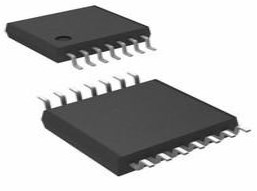 LM224 Operational Amplifier : Application, Pinout and Datasheet
LM224 Operational Amplifier : Application, Pinout and Datasheet06 September 20214025
![KSZ9031RN 4/4 Transceiver Full Ethernet 48-QFN[FAQ]: Datasheet, Features, and Pinout](https://res.utmel.com/Images/Article/16e62b41-be72-4399-a53a-15c4f11e4688.jpg) KSZ9031RN 4/4 Transceiver Full Ethernet 48-QFN[FAQ]: Datasheet, Features, and Pinout
KSZ9031RN 4/4 Transceiver Full Ethernet 48-QFN[FAQ]: Datasheet, Features, and Pinout21 March 2022505
 STM32G431C8T6 Price Comparison: Best Deals and Vendor Analysis
STM32G431C8T6 Price Comparison: Best Deals and Vendor Analysis16 June 2025333
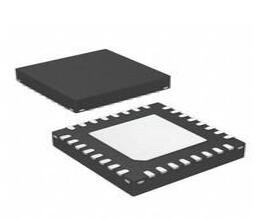 nRF52810 Multiprotocol SoC : Datasheet, Pinout, Schematic
nRF52810 Multiprotocol SoC : Datasheet, Pinout, Schematic11 September 20216957
 A Comprehensive Guide to the Microchip PIC12F629/675 Microcontroller
A Comprehensive Guide to the Microchip PIC12F629/675 Microcontroller29 February 2024573
 XC2S200-5PQG208C and XC2S200-5PQ208C A Detailed Comparison
XC2S200-5PQG208C and XC2S200-5PQ208C A Detailed Comparison06 June 2025100
 2N2369 Switching Transistor: Pinout, Datasheet and Replacement
2N2369 Switching Transistor: Pinout, Datasheet and Replacement13 October 20213491
 Exploring the Microchip PIC16F62820ISS Microcontroller: Architecture, Modules, and Applications
Exploring the Microchip PIC16F62820ISS Microcontroller: Architecture, Modules, and Applications29 February 2024105
 FPGA vs. Microcontroller Technology: Similarities and Differences
FPGA vs. Microcontroller Technology: Similarities and Differences13 March 20243830
 What is a Server CPU?
What is a Server CPU?22 December 202110785
 Advanced CMOS Devices with Wide Bandgap and Ultrawide Bandgap Technologies
Advanced CMOS Devices with Wide Bandgap and Ultrawide Bandgap Technologies15 March 20242985
 The Different Types of Circuit Breakers and Their Applications
The Different Types of Circuit Breakers and Their Applications11 April 20236003
 What is a Hard Disk Drive (HDD)?
What is a Hard Disk Drive (HDD)?31 May 20213962
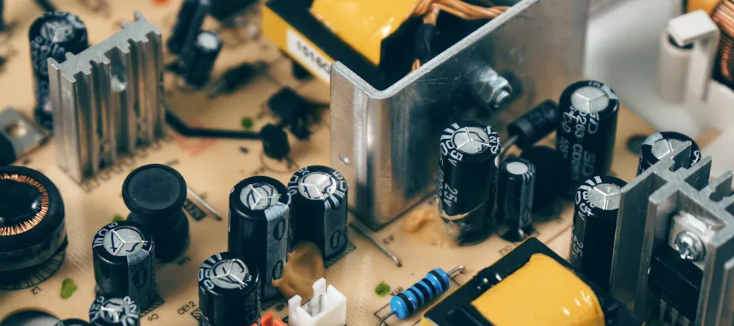 Step-by-Step Guide to 2.2 k Ohm Resistor Color Code in 2025
Step-by-Step Guide to 2.2 k Ohm Resistor Color Code in 202520 August 2025933
 How much do you know about VR Technology?
How much do you know about VR Technology?01 September 20212143
 MLCC: Applications and Future Development
MLCC: Applications and Future Development20 December 20217183
STMicroelectronics
In Stock: 7
United States
China
Canada
Japan
Russia
Germany
United Kingdom
Singapore
Italy
Hong Kong(China)
Taiwan(China)
France
Korea
Mexico
Netherlands
Malaysia
Austria
Spain
Switzerland
Poland
Thailand
Vietnam
India
United Arab Emirates
Afghanistan
Åland Islands
Albania
Algeria
American Samoa
Andorra
Angola
Anguilla
Antigua & Barbuda
Argentina
Armenia
Aruba
Australia
Azerbaijan
Bahamas
Bahrain
Bangladesh
Barbados
Belarus
Belgium
Belize
Benin
Bermuda
Bhutan
Bolivia
Bonaire, Sint Eustatius and Saba
Bosnia & Herzegovina
Botswana
Brazil
British Indian Ocean Territory
British Virgin Islands
Brunei
Bulgaria
Burkina Faso
Burundi
Cabo Verde
Cambodia
Cameroon
Cayman Islands
Central African Republic
Chad
Chile
Christmas Island
Cocos (Keeling) Islands
Colombia
Comoros
Congo
Congo (DRC)
Cook Islands
Costa Rica
Côte d’Ivoire
Croatia
Cuba
Curaçao
Cyprus
Czechia
Denmark
Djibouti
Dominica
Dominican Republic
Ecuador
Egypt
El Salvador
Equatorial Guinea
Eritrea
Estonia
Eswatini
Ethiopia
Falkland Islands
Faroe Islands
Fiji
Finland
French Guiana
French Polynesia
Gabon
Gambia
Georgia
Ghana
Gibraltar
Greece
Greenland
Grenada
Guadeloupe
Guam
Guatemala
Guernsey
Guinea
Guinea-Bissau
Guyana
Haiti
Honduras
Hungary
Iceland
Indonesia
Iran
Iraq
Ireland
Isle of Man
Israel
Jamaica
Jersey
Jordan
Kazakhstan
Kenya
Kiribati
Kosovo
Kuwait
Kyrgyzstan
Laos
Latvia
Lebanon
Lesotho
Liberia
Libya
Liechtenstein
Lithuania
Luxembourg
Macao(China)
Madagascar
Malawi
Maldives
Mali
Malta
Marshall Islands
Martinique
Mauritania
Mauritius
Mayotte
Micronesia
Moldova
Monaco
Mongolia
Montenegro
Montserrat
Morocco
Mozambique
Myanmar
Namibia
Nauru
Nepal
New Caledonia
New Zealand
Nicaragua
Niger
Nigeria
Niue
Norfolk Island
North Korea
North Macedonia
Northern Mariana Islands
Norway
Oman
Pakistan
Palau
Palestinian Authority
Panama
Papua New Guinea
Paraguay
Peru
Philippines
Pitcairn Islands
Portugal
Puerto Rico
Qatar
Réunion
Romania
Rwanda
Samoa
San Marino
São Tomé & Príncipe
Saudi Arabia
Senegal
Serbia
Seychelles
Sierra Leone
Sint Maarten
Slovakia
Slovenia
Solomon Islands
Somalia
South Africa
South Sudan
Sri Lanka
St Helena, Ascension, Tristan da Cunha
St. Barthélemy
St. Kitts & Nevis
St. Lucia
St. Martin
St. Pierre & Miquelon
St. Vincent & Grenadines
Sudan
Suriname
Svalbard & Jan Mayen
Sweden
Syria
Tajikistan
Tanzania
Timor-Leste
Togo
Tokelau
Tonga
Trinidad & Tobago
Tunisia
Turkey
Turkmenistan
Turks & Caicos Islands
Tuvalu
U.S. Outlying Islands
U.S. Virgin Islands
Uganda
Ukraine
Uruguay
Uzbekistan
Vanuatu
Vatican City
Venezuela
Wallis & Futuna
Yemen
Zambia
Zimbabwe



















